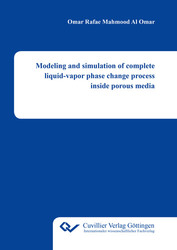| Fachbereiche | |
|---|---|
| Buchreihen (96) |
1378
|
| Nachhaltigkeit |
3
|
| Gesundheitswesen |
1
|
| Geisteswissenschaften |
2364
|
| Naturwissenschaften |
5406
|
| Ingenieurwissenschaften |
1793
|
| Allgemeine Ingenieurwissenschaften | 292 |
| Maschinenbau und Verfahrenstechnik | 862 |
| Elektrotechnik | 686 |
| Bergbau- und Hüttenwesen | 30 |
| Architektur und Bauwesen | 75 |
| Allgemein |
98
|
|
Leitlinien Unfallchirurgie
5. Auflage bestellen |
|
Erweiterte Suche
Modeling and simulation of complete liquid-vapor phase change process inside porous media
Omar Rafae Mahmood Al Omar (Autor)Vorschau
Inhaltsverzeichnis, PDF (41 KB)
Leseprobe, PDF (170 KB)
This work deals with modeling and numerical simulation of fluid flow and heat transfer associated with phase change process inside both isotropic and anisotropic porous media, based on the Two-Phase Mixture Model (TPMM) along with the assumption of Local Thermal Equilibrium (LTE) and Non-Equilibrium (LTNE) conditions. In particular, it demonstrates the necessity and usefulness of a newly proposed smoothing algorithm for handling the sharp discontinuities in the effective diffusion coefficient in order to avoid the occurrence of non-physical “jump” in the predicted temperature distribution during the numerical simulation of the complete phase change process inside porous media. For the purpose of demonstration, one- and two-dimensional phase change problems operated in the Darcy flow regime have been considered.The Finite Volume Method (FVM) has been used on both staggered and non-staggered grid layouts in order to solve the governing conservation equations. In this work, after critically analyzing the drawbacks of the existing enthalpy formulation based on TPMM, a modified formulation has been also developed that can easily accommodate substantial density variations in the single phase regions. The results obtained from the modified enthalpy formulation have been compared with that predicted by the existing modified volumetric enthalpy formulation and excellent agreements have been observed for all tested cases. A thorough parametric study, using both LTE and LTNE models, indicates that the adoption of the proposed smoothing algorithm successfully eliminates “jump” in the predicted temperature distribution and does not alter the overall energy and momentum balance. All tested cases, covering applicable ranges of parametric variations, could be physically interpreted. The methodology is, therefore, recommended for future simulations of complete phase change process inside porous media. The results also show that the modified enthalpy formulation requires significantly less computation time thanmodified volumetric enthalpy formulation.
| ISBN-13 (Printausgabe) | 9783736993709 |
| ISBN-13 (E-Book) | 9783736983700 |
| Sprache | Englisch |
| Seitenanzahl | 218 |
| Umschlagkaschierung | glänzend |
| Auflage | 1. Aufl. |
| Erscheinungsort | Göttingen |
| Promotionsort | Freiberg |
| Erscheinungsdatum | 17.10.2016 |
| Allgemeine Einordnung | Dissertation |
| Fachbereiche |
Ingenieurwissenschaften
|
| Schlagwörter | two-phase mixture model; modified enthalpy formulation; porous media; complete phase change; local thermal equilibrium and non-equilibrium models; staggered and non-staggered grid layouts; smoothing of diffusion coefficient |








